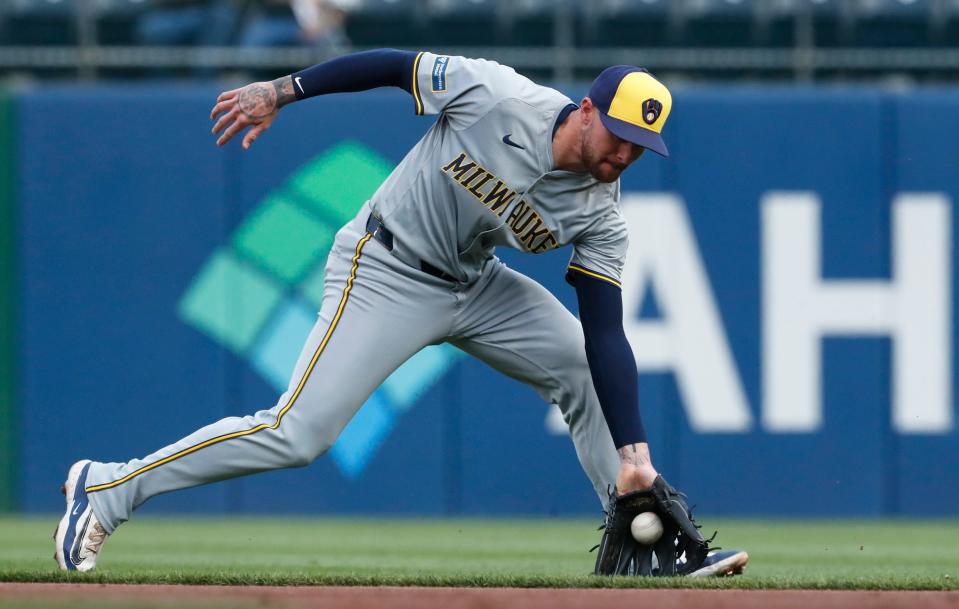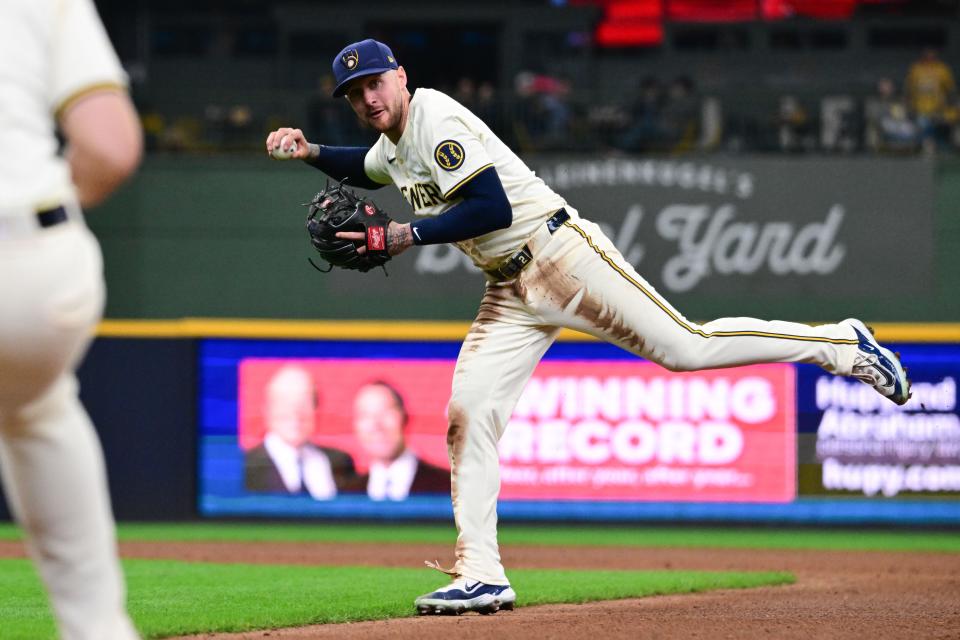The eye test and the advanced metrics disagree about Brice Turang's defense. Which is right?
At some point late in the regular season last year, a discussion broke out among press box denizens at American Family Field regarding potential award winners when the discussion shifted to whether Brice Turang’s defense was truly Gold Glove caliber.
“If you look at the numbers,” a colleague said, “they say he’s pretty average. But all I know is that when I watch him play, my eyes say he's the best second baseman in baseball.”
At the time, I was more inclined to side with the metrics, even if my eyes were telling me Turang was well above average on defense.
But now, a month into another season where it seems like Turang is playing elite defense while the numbers don’t quite agree – Baseball Prospectus had him him as a negative defender going into the day Sunday – I’ve started to shift away from that, leaning far more toward the opinion of my fellow reporter.
I’ve watched him make play after play, whether ranging deep in the hole to his left for a ball or reading a short hop perfectly, while rarely ever, if at all, making a misplay.
It sure seems like Brice Turang can pick it, but let’s not just take my word for it.

What the metrics say about Brice Turang's defense
Turang is far from the first player where the eye test doesn't match the metrics on defense, but it's a quandary nonetheless. These numbers have come a long way in aiding the evaluation of players and are important in the public's perception of players and their values. But when scouts and teams are labeling Turang as an elite glove and the numbers don't back it up, it can lead to some confusion.
Take Outs Above Average, which has become perhaps the most predominantly-cited defensive metric since its inception by Statcast in 2020, for example. Last season, it had Turang at three OAA at second base, which was tied for 14th among all second basemen. Solid, but it's certainly not touting Turang as an elite defender.
Going a step further, Baseball Prospectus had Turang down as a negative defender at -1.6 deserved runs prevented last year.
Making the equation even murkier is the fact that a different, widely-used defensive model, Defensive Runs Saved, view Turang as third-best among all second basemen with 12 DRS.
Those trends have continued in 2024, with Statcast and Baseball Prospectus lower on Turang's defensive value while DRS touts his abilities.
So which one is right?
It’s hard to tell, thanks to the tricky nature of evaluating defense.
“Defense is such a hard thing to quantify,” Brewers general manager Matt Arnold said. “You have the back of the baseball card for pitchers and hitters. (Defense) has really never been on the back of the baseball card. You can see what these other guys do, ball in play outs, pitcher strikeouts – there’s a lot of ways to quantify those other areas. It really is just difficult to quantify it.”
A deeper dive into Turang's glove
Rather than just going entirely off what my eyes or what the public metrics say about Turang’s defense, we can dig a bit more granularly.
A handful of detailed Baseball Savant searches pulled up every play Turang made or possibly could have made this year.
I watched each one and placed it into one of four classifications: Routine (should make it every single time), moderately challenging (plays that he probably should make but wouldn’t be errors), difficult (wouldn’t expect an average defender to make it) and nearly impossible (plays that were, well, nearly impossible).
This methodology, of course, is far from foolproof. Making judgment calls on a large subset of plays can render the entire process subjective, too.
But it ultimately provided for a fairly comprehensive picture of how Turang as a defender, and how many different types of plays he can (and can’t make). In the end, I felt the snapshot it provided about Turang was fairly accurate.
Here are the results

The results came out pretty favorably for Turang. Out of 84 “possible” plays from all four categories that I found, Turang made 77. And most of those he didn’t make fell in the 'difficult' and 'nearly impossible' categories, too.
Among routine and moderately challenging categories, Turang only has had two plays this year he didn’t make – one in each. One was a Willson Contreras grounder up the middle where Turang, who may have even been shielded by the second-base umpire, initially broke the wrong way and missed it. The other was an attempted behind-the-back flip to get a force out at second base against the Padres that went awry.
The other 74 plays in those categories? One-hundred percent clean.
(Attempts to turn a double play as the pivot man were measured separately and are further below in the story).
Turang hasn’t committed an error this year, and while errors aren’t always a great way to judge individual defense, it’s easy to see why he’s error-free. It’s boring, but his foundation as a defender is making all the plays he should make.
Mix in the next level of degree of difficulty – plays that Turang has made 11 of 12 times by this exercise’s count – and you start to see what the Brewers do.
And don’t let the label of ‘moderately challenging’ make you start thinking these are easy plays by any means. These plays were all classified in that category.
On ‘difficult’ plays, I had Turang making six and missing three. A success rate of two-thirds on these types of balls would be about what you would expect out of a good second baseman.
Videos from and used with permission of Baseball Savant/MLB.
The rest were all plays that fell into the category of ‘almost impossible’ that Turang didn’t make. Some public defensive metric models may knock fielders for plays they couldn’t even get to and, thus, couldn’t even make an attempt on. There are some rumblings from those who play a key role in these models that this could be what hurts Turang.
But after watching back every grounder hit in his general vicinity – as well as getting Arnold’s opinion on it – that doesn’t seem to apply to Turang, whose first step and reads are generally very good.
What about turning double plays?
Though it ranks competitively among second basemen, Turang doesn’t necessarily have the strongest arm, per say, so I wondered if there was something happening with double play attempts that was costing him on defensive models.
What I found was, again, that Turang seems to be pretty good at that, too.
On 17 attempts to turn two as the pivot man, Turang has converted 14. His glove-to-hand exchange is exceedingly rapid and as a result I clocked his “pop” time – how much time elapsed from catching the ball at second to when it hits the first baseman’s glove – at 1.33 seconds.
There isn’t exactly all that much information available as to what the average pop time is for a second baseman turning a double play, so I compared Turang with a couple of notable contemporaries: Nico Hoerner, last year’s Gold Glove winner, and Nolan Gorman, whose 24 double plays turned leads baseball.
Turang’s times are better than Gorman and seemingly almost exactly on par with Hoerner.
Even of the two double-play attempts that Turang had a chance to turn and couldn’t (the third failed attempt had no shot), I clocked him at a 1.35 and 1.37 pop time.
Interestingly enough, Turang hasn't started any double plays this season. Watching each grounder to Turang with a man on first over, this seems more of a coincidence than anything. There was only one play — against the Padres when Turang tried to go for the tag of the runner rather than go to second — that even had any chance where maybe Turang could have done more.
Usually, he's doing everything in his power to even make turning two a possibility, like the play below.
The Brewers view Turang as an elite second baseman
The Brewers, for what it’s worth, also see Turang as the same kind of excellent gloveman that the eye test indicates he is.
Part of that stems from what their defensive metrics say.
Arnold, of course, wasn’t going to give away any proprietary information about what, specifically, their metrics say, but indicated the team’s internal numbers do love Turang.
“We think he does a tremendous job out there,” Arnold said. “He keeps getting better. He gets to balls you probably didn’t think he could get to and converts it into an out. Even the combination of that with the little things that are harder to track, like the flip he had (Friday in the 10th inning). The awareness to get to that ball and flip it to second rather than make that throw. It’s the awareness, what he’s able to do in different situations, the athleticism, he’s just really quick.
“I think he’s a really good defender.”
But it isn’t just the metrics that the Brewers utilize to form their reports on Turang’s defense. Arnold and his staff take more of a holistic view when it comes to defense, relying on what their coaches and scouts say about what they’re seeing. The more inputs the better, as Arnold sees it, when you’re dealing with something as abstract as defense.
“Trying to blend the two together is sometimes more art, sometimes more science,” Arnold said. “My hope is that those things align and then if they point in the same direction, then that’s a pretty good sign.”
Do they align when it comes to Turang?
“Oh yeah,” Arnold said. “Same direction.”
This article originally appeared on Milwaukee Journal Sentinel: Brice Turang passes the eye test as elite defender for Brewers

